Interview: Haagen Klaus and “Escaping Conquest” in the Lambayeque Valley
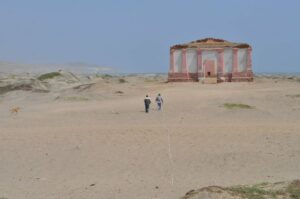
Haagen Klaus is Assistant Professor of Anthropology at Utah Valley University. In 2010 he received a Post-Ph.D. Research Grant from the Wenner-Gren Foundation to aid research on his project ‘Escaping Conquest: Human Biology, Ethnogenesis, and Indigenous Engagement with Colonialism in Eten, Peru’. Recently we spoke to Dr. Klaus to learn more about his excavations in Peru’s Lambayeque Valley, and the unexpected turn his research took there.
Why did you choose the site that you did? More specifically, what is significant about the Lambayeque Valley and why did you select that particular church?
Several factors influenced the careful selection of Eten for this study. Ten years ago, I chose to dedicate a large part of my career to working in the Lambayeque valley of Peru’s desert north coast. Lambayeque was the center of key and influential pre-Hispanic developments from at least 2500 BC – most of which are incompletely understood but are vital to reconstructing the odyssey of human history that unfolded in ancient Peru. My research questions and methodology unite bioarchaeology and mortuary archaeology, so the usually excellent preservation of human remains and funerary contexts in the Lambayeque valley makes it almost a natural laboratory to explore all sorts questions regarding ancient health, disease, social organization, lifestyle, diet, economy, ideology, ecology, adaption, violence, microevolution, and cultural change in ways that few regions of the Americas can provide.
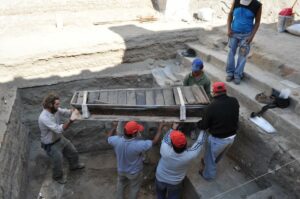
Eten was chosen as the setting for my project’s second stage of investigating European contact and colonization of what came to be known as Peru. Eten featured two church ruins and the remains of its town under the seaside dunes that preserved the site for more than 250 years. Even at the outset, the combination of architectural, mortuary pattern, skeletal biological, settlement pattern, dietary remains, and ecological data present in Eten seemed hard to beat regarding our research design which sought to develop the most holistic reconstruction to date of society, life, and death in this region of Colonial Peru.
Your excavation at the original site lead you to discover something far more interesting – and valuable. Can you tell us about what you found, and how you adapted to such an unexpected change at the site?
During our second and third field seasons at Eten, attention turned to the second of the two church ruins at Eten, which was constructed around A.D. 1776, not long after the colonial town was abandoned. We aimed to document a small number of Late Colonial burials to augment our very basic knowledge of burial patterns and human biology during this later era. Indeed, we encountered such contexts under the brick floor and I think they represent the most exquisitely preserved burials ever found in Lambayeque.
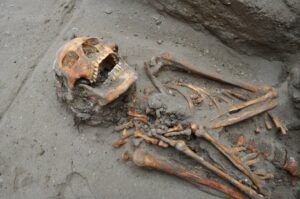
But as we excavated deeper into the site, we found ourselves digging through a fairly hard clay-like layer of fill that was not natural to local geology. We then identified a second, simple earthen floor nearly two meters below the surface, and then, below that, a hyper-dense cemetery. As we expanded outward, it became clear that what we found were the walls and floors of second church within and under the other church. The deeper we went, the more indications from the burials, the architecture, construction techniques, burial styles, and even grave goods indicated the deeper buried church was very old indeed, and clearly dated to the Early Colonial era. It is probably the mission church described in local oral histories founded by a Franciscan missionary in the 1530s. It was abandoned and fell into ruins when a much larger church was constructed in Eten in the 1600s (which was excavated over five months in 2009). When the final church was built in 1776, it appears to have been placed on top of the ruins of the abandoned mission in a recycling of sacred ground.
Finding this completely unexpected mission church and its cemetery took us all off-guard. However, it took little time to realize what it meant – we quickly shifted to adding a whole series of new questions to the work, especially about what life and society was like immediately following the Conquest, and how indigenous Andean survivors of contact and the first few generations of their descendants dealt with their cultural reality and social order being turned upside down.
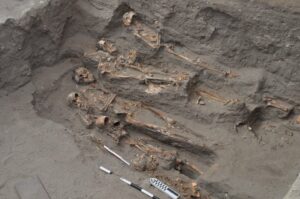
However, some of the native people in Eten did not survive the experience. Among the 254 burials we documented, there were at least six mass graves, the largest containing 22 people. Whatever killed them was acute, and did not leave any marks on their bones. These mass graves point to the likelihood of epidemic disease driving aspects of mortality patterning in early Colonial Eten. However, this appears to have been one kind of health stress functioning on a very particular episodic or acute level. When we examined more than a dozen markers of childhood and adult health that are recorded in the bones and teeth of the people of Eten, it was clear they had lived lives characterized by generally good health and nutrition. This is very different from our previous study in nearby Colonial Mórrope (2004-6), where we found extremely high levels of stress and disease. So, while episodic impacts of European diseases may have been unavoidable, Eten in general had evidently “escaped” many of the negative chronic health consequences of living in the 16th century colonial world. They were quite healthy overall. The native people of Eten actively adapted to and buffered against the negative impacts of conquest, no doubt aided by the fact that Eten was located in a region rich with nutritional resources and other favorable ecological conditions.
You consider “the grave” and mortuary patterns in general to be a unified “datum point” where biological and cultural anthropological concerns can meet and play off each other. Why are graves particularly well-suited?
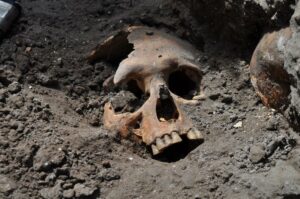
As a number of my colleagues have stated in the past, burials are by far the most information-packed kind of deposit in the archaeological record. I can only echo that vision with conviction and passion. But it’s not only the quantity of information about the past that can be gained by such an approach – it the quality, and what it tells you. The rituals that human beings weave around death, and the traces that are left in or around a grave, are exceptionally rich windows to begin building a holistic understanding of an extinct society and their ideas and understandings about themselves. The human remains in a grave provide direct evidence about the social ways people lived their lives. All forms of archaeological evidence are important, but burials are particularly vital to an archaeology that is humanized, and whose purpose is to explicitly tell a part of the story of the human experience.
I would argue that an integrated approach towards burials in anthropology is necessary, logical, and just makes sense. It can be something that erases the traditional boundaries between mortuary archaeology and bioarchaeology, which I think is an important theoretical and methodological development that is beginning to emerge among some anthropologists. It is a particularly vital perspective and conceptual “toolbox” to bring to Andean archaeology, partially due to the nature of the archaeological record, burials, and human remains that still await discovery here.
Your work eschews the popular colonial contact model of “collapse” for a more complex outlook. In your view, what is wrong with the former paradigm, and what would you like to see change in popular understandings of postcontact Latin America?
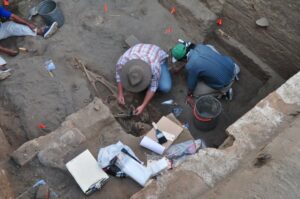
The former paradigm was built on earlier ideas, and as time, evidence, and science has progressed, anthropological understandings of contact and collapse have shifted from universalist and positivist perspectives to one guided by the last 25-30 years of evidence (especially bioarchaeological evidence) that shows contact was such a dizzyingly complex phenomenon. Contact was fundamentally something that unfolded differently everywhere, especially on local levels, as our work shows. This means we have to abandon preconceived notions about contact and conquest. It was also a foundational event and process in the formation of our present world, culture, and patterns of modern human biology (which are not simply limited to the effects of demographic collapse on indigenous genetic variation, as is often assumed).
For me, one of the most intriguing elements about conquest deals with the meeting of disparate cultures and peoples. Rather than one society overwhelming or annihilating another (as is so often imagined by our popular culture), archaeology and biological anthropology are in increasingly telling us that fledgling, constantly transforming, hybrid societies emerged from the so-called “collision of worlds.” Such social formations are born through the negotiations and tensions of colonial settings, creative forms of native resistance, the ambitions and agendas of the colonizers and the colonized, local ecology, other factors leading to a kind of fragile and tentative “in-between-ness.” I am speaking directly to the concept of ethnogenesis: sustained colonial encounters tended to create new societies, new kinds of cultural realities, and new kinds of people that never had existed before, and in some cases such as Eten, exist no longer. These were the bridges between pre-Hispanic worlds and the one we live in today.
What’s next for you and your research? How do you see this project developing in the future?
With the conclusion of the past three years working in Eten, the first order of business is to finalize the analysis of a broad spectrum of archaeological, bioarchaeological, zooarchaeological, paleobotanical, and biogeochemical data. By the end of 2013, I aim to have a major monograph manuscript completed describing our findings along with several other related writing projects.
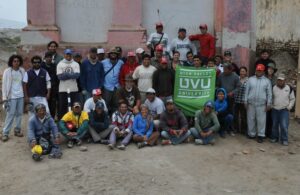
However, the findings from Eten generate nothing short of an entire spectrum of new questions about the Early Contact period in coastal Peru. About a week ago, I believe I have possibly located the buried ruins of one of the earliest and most important colonial settlements in this region of Peru — a town called Lambayeque Viejo — which was abandoned around 1578. I think Lambayeque Viejo has the potential to provide an exquisitely detailed snapshot of the initial colonial conjunction here, and provide vital new perspective about the nature of cultural change, religious conversion, indigenous resistance, health, epidemic disease, and mortuary practices that emerged just after the conquest. This may well be the setting in the next stage of our investigation.
After that, I have a tentative list of Colonial and pre-Hispanic sites in the Lambayeque region to excavate over the next 25 years… But how exactly that will unfold is yet to be seen. Field archaeology can be unpredictable and lead one in unanticipated and exciting directions!
Are you a current or past Wenner-Gren grantee and would like to be interviewed for our blog? Contact Daniel (dsalas@wennergren.org) for more information.